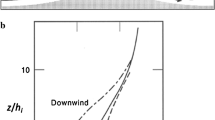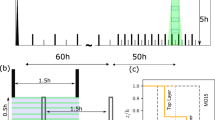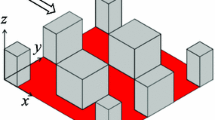Abstract
An understanding of how topography, including that covered by a plant canopy, influences the flow and turbulence is important in many meteorological and micrometeorological applications. We revisit the framework of Finnigan and Belcher (Q J Roy Meteorol Soc 130:1–29, 2004) for neutral flow over sinusoidal two-dimensional topography covered by a canopy and present a minor modification that enables a formal match between the forms for the flow within and above the canopy, including within the deep canopy. The modification then allows the easy extension of the framework to generalised two-dimensional topography. The revised framework affirms the conclusions of Finnigan and Belcher (op.cit.); above the canopy the flow perturbations are maximised near to where the perturbation pressure is a minimum, whereas deep within the canopy the flow perturbations are maximised when the streamwise gradient of the perturbation pressure is largest. However, the extension to general topography strongly illustrates that it is the pressure perturbation, not the hill shape directly, that controls the magnitude and location of the topographic impacts on the flow. For isolated ridges with a plateau, the flow perturbations above the canopy maximise, not at the ridge crest, but where the hill curvature is largest. Multiple recirculation regions can also exist within the canopy, as determined by the streamwise gradient of the pressure perturbation. These results indicate that knowledge of the terrain over a larger area than hither-to-thought is required to assess whether the use of micrometeorological techniques is appropriate at individual sites.
Similar content being viewed by others
References
Aubinet M, Berbigier P, Bernhoffer CH, Cescatti A, Feigenwinter C, Granier A, Grüwald TH, Havrankova K, Heinisch B, Longdoz B, Marcolla B, Montagnani L, Sedlak P (2005) Comparing CO 2 storage and advection conditions at night at different CARBOEUROFLUX sites. Boundary-Layer Meteorol 116: 63–94
Baldocchi D, Falge E, Gu L, Olson R, Hollinger D, Running S, Anthoni P, Bernhofer C, Davis K, Evans R, Fuentes J, Goldstein A, Katul G, Law B, Lee X, Malhi Y, Meyers T, Munger W, Oechel W, Paw U KT, Pilegaard K, Schmid HP, Valentini R, Verma S, Vesala T, Wilson K, Wofsy S (2001) FLUXNET: a new tool to study the temporal and spatial variability of ecosystem-scale carbon dioxide, water vapor, and energy flux densities. Bull Am Meteorol Soc 82(11): 2415–2434
Baldocchi D, Finnigan J, Wilson K, Paw U KT, Falge E (2000) On measuring net ecosystem carbon exchange over tall vegetation on complex terrain. Boundary-Layer Meteorol 96: 257–291
Belcher SE, Hunt JCR (1998) Turbulent flow over hills and waves. Ann Rev Fluid Mech 30: 507–538
Belcher SE, Wood N (1996) Form and wave drag due to stably stratified turbulent flow over low ridges. Q J Roy Meteorol Soc 122: 863–902
Belcher SE, Finnigan JJ, Harman IN (2008) Flows through canopies in complex terrain. Ecol Appl 18(6): 1436–1453
Belcher SE, Jerram N, Hunt JCR (2003) Adjustment of a turbulent boundary layer to a canopy of roughness elements. J Fluid Mech 488: 369–398
Finnigan JJ, Belcher SE (2004) Flow over a hill covered with a plant canopy. Q J Roy Meteorol Soc 130: 1–29
Harman IN, Finnigan JJ (2007) A simple unified theory for flow in the canopy and roughness sublayer. Boundary-Layer Meteorol 123: 339–363
Hunt JCR, Leibovich S, Richards KJ (1988a) Turbulent flow over low hills. Q J Roy Meteorol Soc 114: 1435–1470
Hunt JCR, Richards KJ, Brighton PWM (1988b) Stably stratified shear flow over low hills. Q J Roy Meteorol Soc 114: 859–886
Inoue E (1963) On the turbulent structure of airflow within crop canopies. J Meteorol Soc Jpn 41: 317–326
Jackson PS, Hunt JCR (1975) Turbulent wind flow over a low hill. Q J Roy Meteorol Soc 101: 929–955
Katul GG, Finnigan JJ, Poggi D, Leuning R, Belcher SE (2006) The influence of hilly terrain on canopy-atmosphere carbon dioxide exchange. Boundary-Layer Meteorol 118: 189–216
Lee X (2000) Air motion within and above forest vegetation in non-ideal conditions. For Ecol Manage 135: 3–18
Neff DE, Meroney RN (1998) Wind-tunnel modelling of hill and vegetation influence on wind power availability. J Wind Eng Ind Aerodyn 74–76: 335–343
Patton EG, Katul GG (2009) Turbulent pressure and velocity perturbations induced by gentle hills covered with sparse and dense canopies. Boundary-Layer Meteorol 133: 189–217
Patton EG, Sullivan PP, Ayotte KW (2006) Turbulent flow over isolated ridges: influence of vegetation. In: Proceedings of the 17th symposium on boundary layers and turbulence, American Meteorological Society, San Diego, CA
Poggi D, Katul GG (2007a) An experimental investigation of the mean momentum budget inside dense canopies on narrow gentle hilly terrain. Agric For Meteorol 114: 1–13
Poggi D, Katul GG (2007b) Turbulent flows on forested hilly terrain: the recirculation region. Q J Roy Meteorol Soc 133: 1027–1039
Poggi D, Katul G (2007c) The ejection-sweep cycle over bare and forested gentle hills: a laboratory experiment. Boundary-Layer Meteorol 122: 493–515
Poggi D, Katul GG, Finnigan JJ, Belcher SE (2008) Analytical models for the mean flow inside dense canopies on gentle hilly terrain. Q J Roy Meteorol Soc 134: 1095–1112
Raupach MR, Finnigan JJ, Brunet Y (1996) Coherent eddies and turbulence in vegetation canopies: the mixing layer analogy. Boundary-Layer Meteorol 78: 351–382
Ross AN, Vosper SB (2005) Neutral turbulent flow over forested hills. Q J Roy Meteorol Soc 131: 1841–1862
Weng W (1997) Stably stratified boundary-layer flow over low hills: a comparison of model results and field data. Boundary-Layer Meteorol 85: 223–241
Wood N, Hewer FE, Belcher SE (1998) Comments on ‘Stably stratified boundary-layer flow over low hills: a comparison of model results and field data’ by Wengsong Weng. Boundary-Layer Meteorol 88: 323–332
Author information
Authors and Affiliations
Corresponding author
Rights and permissions
About this article
Cite this article
Harman, I.N., Finnigan, J.J. Flow Over Hills Covered by a Plant Canopy: Extension to Generalised Two-Dimensional Topography. Boundary-Layer Meteorol 135, 51–65 (2010). https://doi.org/10.1007/s10546-009-9458-3
Received:
Accepted:
Published:
Issue Date:
DOI: https://doi.org/10.1007/s10546-009-9458-3




